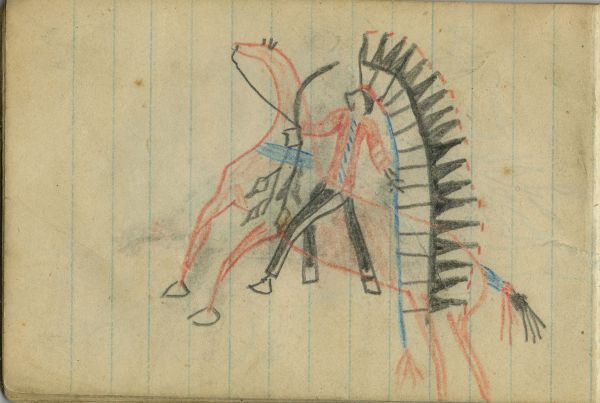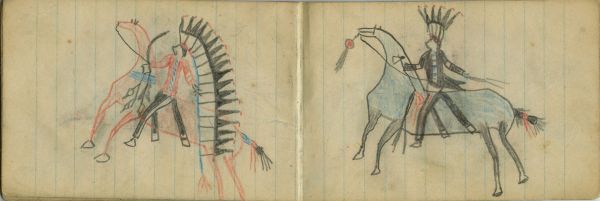WAR: Warrior on Red Horse Wears Full Banner Headdress and Holds Saber
Ethnographic Notes
This page, along with page 29, were drawn upside down in the ledger. Horizontal WAR: Warrior on Red Horse Wears Full Banner Headdress and Holds Saber This warrior resembles those in the hunting scenes, with elongated body and featureless head. Here, the man, presumably Wild Hog, is dressed for battle. His single-trail headdress has eighteen immature golden eagle feathers, tipped with red. Red at the man�s head indicates the red cap of the headdress, and the feathers are set into blue cloth with a red tassel at the end. The warrior wears a red shirt with a strip of blue bars, perhaps beadwork, attached vertically from neck to waist. The cuffs have white stripes. He wears the same matching dark (lead-pencil shaded) breechclout and leggings of previous plates. In his right hand he holds the horse�s reins and also the saber seen on the inside cover of this ledger. The sword curves upward, and two streamers dangle below. Feathers are attached to the streamers. The horse is outlined in red except for his front hooves, which are dark. The horse rises diagonally upward on the page, so the rear hooves extend below the page. The horse has bands of blue around his shoulders. His tail is tied with a whorl or ruff. It is painted blue or tied with blue cloth; between the blue and the whorl is red cloth, with ends dangling. The man and horse are formally dressed for war. The four 1879 Dodge City ledger books (Wild Hog-Kansas State Historical Society; Northern Cheyenne-Kansas State Historical Society, Porcupine-Schoyen, and this one) most often show people�s feet as resembling hooves rather than moccasins, and in this drawing, the similarity of the horse�s hooves and the man�s feet is apparent. Candace Greene wrote Ramon Powers the following interpretation ��almost all the figures [in the Wild Hog and other Northern Cheyenne ledgers from 1879 Kansas State Historical Society ledgers] feet are hoof-like, and seldom in these ledgers are feet or moccasins drawn in normal proportion� (see Low and Powers, 2012: 13). Marjane Ambler quotes Notame�hehe, or North Woman, in �Coming Home� (We, The Northern Cheyenne People, 2008: 30), whose oral account compares the Northern Cheyenne refuges to buffalo herds that scatter in cold weather. Gail Small, a descendant of Fort Robinson Breakout survivor Iron Teeth Woman, tells of the fleeing Northern Cheyenne people having no moccasins (Lawrence, Kansas talk at Haskell Indian Nations University, 12 August 2009).

